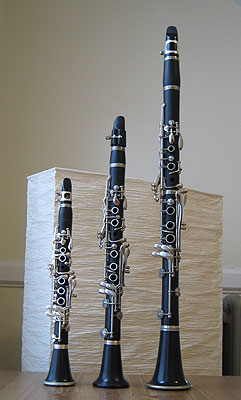Clarinets

Clarinets were developed in the late 1600s and were made of wood. Less expensive clarinets made of plastic or composite material are useful for outdoor playing. Clarinets produce a variety of sound qualities based on the register where they are being played. In the low register they produce a dark quality. In the highest register they can cut through an ensemble with a clear, precise sound.
Clarinets have a series of holes and mechanisms that are used to cover holes. As more and more holes are covered, the sound gets lower and lower. Clarinets consist of five pieces, or sections, including the mouthpiece, the barrel, the top joint, the bottom joint, and the bell. It must be assembled before each use.
Clarinets come in a variety of sizes. From smallest to largest would be the E flat soprano, Bb soprano, A soprano, Eb alto, Bb bass, Eb contrabass, and the largest is the double B flat contrabass. The larger the instrument, the lower the sound.
Clarinets can be found in orchestras, concert bands, jazz bands, Dixieland bands, chamber groups, and clarinet choirs. Clarinets work very well as solo instruments or in groups and seem to fit well into classical as well as modern music.
Study the image provided and listen to the sound sample of the clarinet to gain an understanding of this instrument.
 Listen to a sample of the clarinet:
Listen to a sample of the clarinet:

